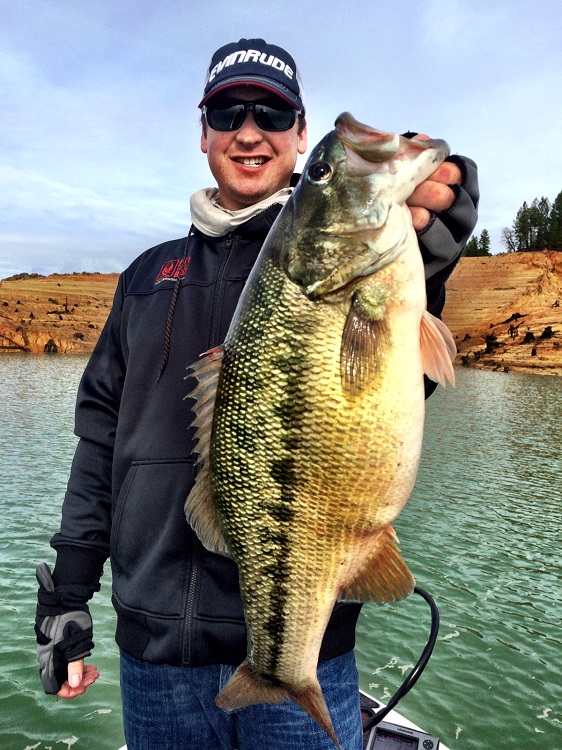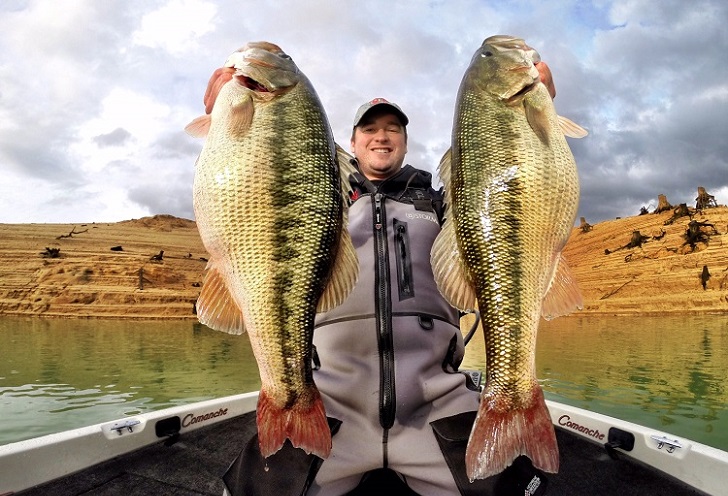

Everyone
wants a big spot, and most would greatly appreciate a big spot with lots of big
spots. Truth is, though, that those giant spotted bass that California has been
pumping out of late aren’t exactly homebodies – you gotta go find ‘em.
FLW pro Cody
Meyer knows this well. He’s been on the receiving end of some incredible
spotted bass action – the best of which was a mind-blowing 5-fish limit of 42.73 pounds. However, he’s
quick to note that you simply cannot assume any day-to-day repetition.
From his
banner day, Meyer’s offers this lesson: “There were two high 9-pounders and a
couple of 8’s. We were throwing back 7-pounders. We pulled up and started off
by catching an 8 ¼-pounder, we went to another spot and my partner caught a 9,
went to another spot and I caught a 7, a 7 ½ and an 8. On our next spot, I
caught 9 ¾.
“At the end
of the day we pulled up on this point and we were catching a 7- or 8-pounder on
every cast. We only stopped because I
had a doctor’s appointment. We thought we’d come back the next day and get some
Go-pro footage, but we went back and only caught one fish.”
Key here is
mobility – the kind that spotted bass display. Yesterday’s bounty can be
today’s desert. But putting in your time may lead to a real hay-maker.
“When you
find them, you can have a dream day,” Meyer said. “And when you don’t, you’re
not necessarily doing anything wrong, you just have to keep moving until you
find them. “
GO WITH THE GROCERIES
There’s one
main reason the west coast spots grow so big – food, lots and lots of
belly-busting food. Topping the list are trout and kokanee salmon (land-locked
sockeye). Huge schools of this hefty forage presents a ready-made source of
fattening chow that pushes spots bigger and bigger.
“California
is producing the big spots because of the trout and kokanee,” Meyer said.
“They’re so high in protein and so fatty that the spots can eat one or two and
they don’t have to use a lot of energy to put on the weight.
“Unlike an
eastern spotted bass lake with blueback herring, which are harder to catch
because they’re so fast, western spots can just follow those schools of trout
and kokanee around and feed whenever they get hungry. Sometimes, they won’t
even be feeding, they’ll just follow those schools around and every few hours,
they’ll decide to eat one.”
FIND THOSE FATTIES
Although he
knows not every day will yield a limit of
40-plus, Meyer still approaches each spotted bass outing optimistically
and he has a game plan for deep fish in 50 feet or more, as well as those
roaming shallow in 10-20.
In his
preferred scenario, Meyer focuses on the deep stuff, 40 feet or more, during
fall and winter, as well as the dog days of summer. Narrowing down the playing field
is Job 1 and he does that by finding the buffet.
“The first
think I look for is baitfish; whether it’s a lake with only kokanee, or (other
forage), they’re going to be around the bait,” he said. “Typically when you
idle around and find the bait, you note the depth where the bait is holding and
then you want to match the bottom structure to the bait.
“For
example, if you find the bait in 50 feet of water and there’s a rock pile that
pops up in 50 feet, that’s probably going to be a good place for spotted bass.
There in that depth for a reason – either the baits’ feeding on something or
there’s a thermocline. It’s really quick way to establish a pattern when you’re
fishing deep water.”
That’s
important for two reasons: First, time management is always a concern for
tournament fishermen and casual anglers alike. You want to get the most out of
your day and running around the lake in a blind frenzy is typically
counterproductive.
Moreover,
Meyer said that the deep fish are usually the tanks.
“On these western
lakes, I always say that if you can catch them deep, you’re going to have a
¼-pound bigger fish on average; and at the end of the day, that pound and a
half or pound and a quarter difference (in your limit) is going to go a long
way,” he said.
“The deep
fish are bigger because there’s a lot more bait down there. There may be fish
shallow eating crawdads too, but when you find the bait deep, they’re going to
be so grouped up, it’s just easy for the bass to stack up and prey on them.”
As Meyer
notes, the big spots are well aware of how easy it is to just sit on that deep
structure and wait for the bait to come to them.
For
targeting deep spots, Meyer’s rig of choice is a dropshot baited with a Strike
King KVD Dream Shot worm in a basic shad pattern. It’s easy to fish effectively
in substantial depths and when the spots are chewing, the wait is usually
short.
Meyer said a
close second is a ¾- to 1-ounce football head jig with a Strike King Rage Tail
Craw. For those fish with crustaceans on their mind, bumping along the bottom
and presenting a plastic with no lack of enthusiasm is a good way to meet a
spotted fatty.
“In that
deep water, color isn’t all that important because it’s harder for the fish to
see in the darker depths,” Meyer said. “That’s why you want something with a
lot of action so they can feel it and locate it deep.”
Now, for the
times he has to look for spots in shallow habitat of, say 10-20 feet, Meyer
feels his best bet is usually on a long point. Here, a swimbait is his search
tool and while big models like the classic Huddlestons will certainly catch
fish, he does a lot of damage with a 4-inch Strike King Swimming Caffeine Shad.
“I’ll roll
up on a point and cover the entire depth range,” Meyer said of his search plan.
“Once you find them with the swimbait, you can sit down and fish more
effectively with a shaky head and a Strike King finesse worm.”
Wherever he
looks for spots, Meyer said that the make-it/break-it element is his
electronics. Staying on top of these nomadic fish is no easy task and unless
you get eyes on what’s happening down below, yours will be little more than a
guess fest.
Case in
point: A recent trip found Meyer and a friend, prospecting the bottom in about
100 feet. Dismal were their results until they noticed big marks holding 20
feet down in the water column – not surprisingly, around bait schools.
Adjusting the presentations enabled Meyer to target and catch several of these
suspenders.
Hard to do
that when you don’t know the fish are there. Spots are a sneaky lot, so look
for the food, pinpoint where they’re holding and enjoy the slugfest.


 Advertising
Advertising